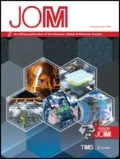Abstract
The Teniente converter is the main fusion equipment of the Hernán Videla Lira Foundry, in which matte, slag and gases are produced. The matte produced in the smelting process of copper concentrates in the Teniente converter contains variable percentages of copper. The expected range of copper in the matte varies from 74% to 76%. It is important to obtain these percentages of copper in the matte, since the copper that is not obtained is lost in the slag. In this work, we propose a predictive model with an artificial neural network to predict the percentage of copper that will be obtained in the matte produced in the converter so that the prediction allows modifying the different variables involved in advance. The results obtained are promising and present a mean-squared error of 0.1004 and an adequacy index of 0.9 for 140 test data.





Similar content being viewed by others
References
C. Herrera, Merger of Concentrates in Hernán Videla Lira Foundry. www.sonami.cl. Accessed 1 July 2014. (in Spanish).
National Mining Company, ENAMI. Strategic Plan 2015–2018 (2014). (in Spanish).
National Copper Corporation of Chile, CODELCO. www.codelcoeduca.cl. Accessed 15 Oct 2017. (in Spanish).
M. Duran, Simulation of the copper concentrate drying process. Undergraduate thesis, Pontifical Catholic University of Valparaíso, Valparaíso, Chile, 2013. (in Spanish).
A. Pulgar, K. Carvajal. Modeling of the teniente converter trough artificial neural networks, in Ibero-American Conference on Software Engineering and Knowledge Engineering (2018).
G. Richter. Challenges, foundry and refinery Codelco. www.ecometales.cl. Accessed 10 Oct 2015. (in Spanish).
A. Kordijazi, T. Zhao, J. Zhang, K. Alrfou, P. Rohatgi. A review of application of machine learning in design, synthesis, and characterization of metal matrix composites: current status and emerging applications. JOM, pp. 1–15 (2021).
F. Nakhaei, M. Irannajad, Int. J. Min. Sci. Technol. 25(6), 983 (2015)
A. Azizi, R. Ghaedrahmati, N. Ghahramani, R. Rooki, Int. J. Min. Miner. Eng. 7, 139 (2016)
H. Lu, An neural network model for the Fe/SiO\(_2\) ratio in copper flash smelting slag using improved back propagation algorithm, in Advanced Materials Research, vol. 524, pp. 1963–1966. Trans Tech Publ (2012).
C. Yin, Z. Luo, M. Ni, K. Cen, Fuel 77(15), 1777 (1998)
B. Shahbazi, B. Rezai, Int. J. Miner. Metall. Mater. 17, 526 (2010)
P. Villarroel, Implementation of a gas collection hood in the slag discharge sector of the Teniente Converter of the copper smelter. Undergraduate thesis, School of Mechanical Engineering, Pontifical Catholic University of Valparaíso, Valparaíso, Chile, 2018. (in Spanish).
B. Santelices, Innovation based on scientific knowledge: study in tribute to the 50 years of the Institute of Chile and the Chilean Academy of Sciences. Chilean Academy of Sciences (2013). (in Spanish).
M. Schaaf, Z. Gómez, A. Cipriano, J. Process Control 20(1), 3 (2010)
Codelco, Operational support manual. Technical report (2005). (in Spanish).
A. Suárez, Z. Gómez, Ibero-Am. J. Autom. Ind. Inform. RIAI 8(1), 54 (2011). (in Spanish)
N. Cardona, Contribution to the Physicochemical Analysis of Copper Losses in Slag. PhD thesis, Department of Metallurgical Engineering, University of Concepción, Concepción, Chile (2011). (in Spanish).
C. Collao, Design and implementation of control loop of flux addition in Teniente Converter. Undergraduate thesis, School of Electronics, Metropolitan Technological University, Santiago, Chile (2008). (in Spanish).
K. Gurney, An Introduction to Neural Networks (CRC Press, Boca Raton, 1997)
R. Vang-Mata, Multilayer Perceptrons: Theory and Applications (Nova Science Publishers, New York, 2020)
T. Rashid, Make Your Own Neural Network, 1st edn. (CreateSpace Independent Publishing Platform, North Charleston, 2016)
C. Zambrano, D. Rojas, K. Carvajal, G. Acuña, Ingeniare. Chil. Eng. J. 19, 369 (2011). (in Spanish)
M. Hagan, H. Demuth, M. Beale, and O. De Jesús, Neural Network Design. Martin Hagan, 2nd edition (2014).
Y. Xu, R. Goodacre, J. Anal. Test. 2(3), 249 (2018)
J. J. Moré, The Levenberg–Marquardt algorithm: implementation and theory, in Numerical Analysis, pp. 105–116. Springer (1978).
Acknowledgements
We are deeply grateful to Dr. Karina Carvajal Cuello (RIP) for defining the guidelines of this research, to the Postgraduate Direction of the University of Atacama and to the Hernán Videla Lira Foundry of the National Mining Enterprise (ENAMI) for their support for conducting this research.
Author information
Authors and Affiliations
Corresponding author
Ethics declarations
Conflict of interest
The authors declare that they have no conflict of interest.
Additional information
Publisher's Note
Springer Nature remains neutral with regard to jurisdictional claims in published maps and institutional affiliations.
Rights and permissions
About this article
Cite this article
Riffo, V., Pulgar, A. Predictive Model of the Percentage of Copper in the Matte of the Teniente Converter Through an Artificial Neural Network. JOM 74, 396–404 (2022). https://doi.org/10.1007/s11837-021-05052-8
Received:
Accepted:
Published:
Issue Date:
DOI: https://doi.org/10.1007/s11837-021-05052-8




